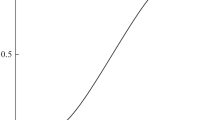Summary
The definition of the average error of numerical methods (by example of a quadrature formula\(\tilde S(f) = \sum\limits_{i = 1}^n {c_i f(a_i )}\) to approximateS(f)=∝ f d μ on a function classF) is difficult, because on many important setsF there is no natural probability measure in the sense of an equidistribution. We define the average a posteriori error of an approximation\(\tilde S\) by an averaging process over the set of possible information, which is used by\(\tilde S\) (in the example of a quadrature formula,N(F)={(f(a 1), ...,f/f∈F} is the set of posible information). This approach has the practical advantage that the averaging process is related only to finite dimensional sets and uses only the usual Lebesgue measure. As an application of the theory I consider the numerical integration of functions of the classF={f:[0,1]→ℝ/f(x)−f(y)|≦|x−y|}. For arbitrary (fixed) knotsa i we determine the optimal coefficientsc i for the approximation\(\tilde S(f) = \sum\limits_{i = 1}^n {c_i f(a_i )}\) and compute the resulting average error. The latter is minimal for the knots\(a_i = \frac{{3i - 2}}{{3n - 1}}(i = 1,...,n)\). (It is well known that the maximal error is minimal for the knotsa i \(a_i = \frac{{2i - 1}}{{2n}}(i = 1,...,n)\).) Then the adaptive methods for the same problem and methods for seeking the maximum of a Lipschitz function are considered. While adaptive methods are not better when considering the maximal error (this is valid for our examples as well as for many others) this is in general not the case with the average error.
Similar content being viewed by others
References
Niederreiter, H.: Quasi-Monte Carlo methods for global optimization. 4th Pannonian Symp. on Math. Statist. Bad Tatzmannsdorf (1983) Reidel 1985
Novak, E.: On average case errors in numerical analysis. (To appear in J. Complexity)
Sukharev, A.G.: Optimal strategies of the search for an extremum. USSR Comput. Math. Math. Phys.11, 119–137 (1971)
Sukharev, A.G.: Best sequential search strategies for finding an extremum. USSR Comput. Math. Math. Phys.12, 39–59 (1972)
Traub, J.F., Woźniakowski, H.: A general theory of optimal algorithms. New York: Academic Press 1980
Traub, J.F., Wasilkowski, G.W., Woźniakowski, H.: Information, uncertainty, complexity. Reading: Addison-Wesley 1983
Traub, J.F., Wasilkowski, G.W., Woźniakowski, H.: Average case optimality for linear problems. Theor. Comput. Sci.29, 1–25 (1984)
Wasilkowski, G.W.: Some nonlinear problems are as easy as the approximation problem. Comput. Maths. Appl.10, 351–363 (1984)
Wasilkowski, G.W.: Average case optimality. J. Complexity1, 107–117 (1985)
Wasilkowski, G.W., Woźniakowski, H.: Can adaption help on the average? Numer. Math.44, 169–190 (1984)
Author information
Authors and Affiliations
Rights and permissions
About this article
Cite this article
Novak, E. The average a posteriori error of numerical methods. Numer. Math. 50, 245–252 (1986). https://doi.org/10.1007/BF01390432
Received:
Issue Date:
DOI: https://doi.org/10.1007/BF01390432



